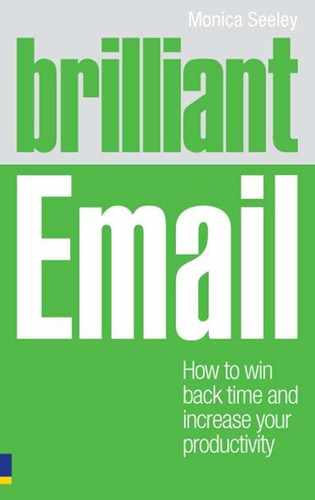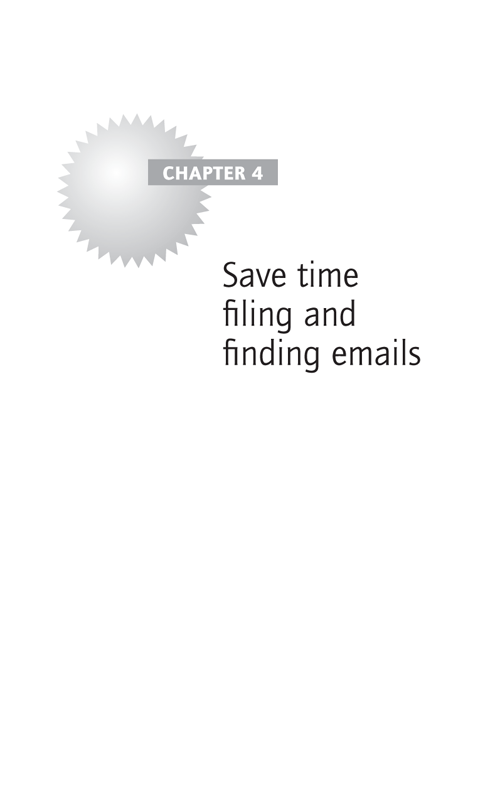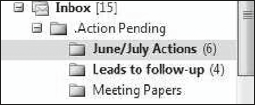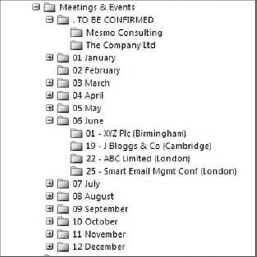Carolee Cannata
The way you folder (or don’t folder) emails is part of your email DNA fingerprint, as highlighted in the Introduction. In seven out of ten cases, I find that there is a direct correlation between the state of a person’s desk or workspace and their inbox. This chapter covers:
- the pros and cons of using folders to park your emails
- what makes an effective folder structure
- guidelines and templates for implementing your own folder structure
- tips on how to start and keep on track.
To folder or not to folder …
There are those who meticulously file each email and have a complex hierarchical folder structure with a large number of main folders and sub-folders (often in the hundreds). They will park each email in a folder after reading it, regardless of which of the ‘Four D’s’ category it falls into – Deal, Delete, Delegate or Defer (see Chapter 1). Their aim is a clear empty inbox – what author and broadcaster Merlin Mann terms Inbox Zero – until the next avalanche of new email arrives (see http://inboxzero.com). Others just leave them all in their inbox.
Neither approach is right nor wrong. The key is not to let email pile up unread in your inbox. One of the major email time thieves is scrolling up and down looking for things. All email software has some level of search function (from fairly basic to quite granular and sophisticated). However, these still often return several screens of potentially relevant emails through which you then have to scroll.
If you feel you could never be organised enough to folder your emails and can’t function unless you are surrounded by piles of disorganised papers and email, then skip this chapter. If you want to improve your personal productivity then read on.
The pros and cons of folders
A good filing system is critical for processing and organizing your stuff.
David Allen
Benefits of using folders
- Searching is faster, especially if you use a preview or reading pane.
- Housekeeping (for example, deleting old emails) takes less effort.
- You can use ‘Rules’ (see page 24) to move less important emails out of the main inbox, enabling you to see important emails more easily.
- You can create ‘confidential’ folders into which certain emails can be moved automatically during times when someone else is dealing with your email (for example, when you’re on leave.)
- Significant increase in the feeling of being in control of your mailbox because there are fewer emails in the main inbox.
- Makes it easier to keep within your mailbox limits. Being shut out of your inbox because you are over the limit is perhaps one of office life’s most stressful moments, especially when you need to send something urgently.
Downsides of using folders
- It takes time to set up and maintain a good folder structure. (Merlin Mann suggests that foldering is a total waste of your time, given the power of today’s search engines.)
- All inboxes and their folders need housekeeping – clearing out those emails past their sell by date and those which if kept might constitute a breach of compliance with the Data Protection Act.
- Folders are not suited to everyone’s personality or behaviour and can cause some people more stress and anxiety than leaving all their emails in the inbox.
- Despite the fact that mobile devices like the iPhone, BlackBerry and Android smartphones are now so sophisticated, synchronising folders and seeing emails stored in folders can still be sufficiently problematic as to deter even the most organised person.
The verdict
Overall, most time management experts, organisation gurus and psychologists would promote using a sound reliable folder structure as the foundation for increased productivity and less stress.
Additionally, I think there are probably many lost business opportunities in large inboxes. In early 2000, the Delphi Consultancy Group estimated that every piece of paper in a business costs US $120 and, despite that, around 15 per cent of them are lost. That’s quite an overhead for any business even before you consider the potential lost business opportunities among the lost paper. For ‘paper’, these days read ‘email’. Many who do not believe in foldering have huge inboxes containing thousands of emails and most have no idea what is in their inbox beyond the first two viewing screens.
What makes an effective folder structure?
It should take you less than one minute to pick something up out of your in-basket or print it from an email.
David Allen
View your email folders as you would a filing cabinet. Decide on the top-level structure, then add some sub-folders and sub-sub-folders if necessary. For example:
- Projects
- Pending
- Current – to action
- Next month – to action
- Clients
- Leads to follow up
- People’s names
- Topic (such as ‘HR’, ‘PR’)
- Meetings
- Newsletters
- Social matters
- Financial.
Your folders must work for you. Look at the examples on www.brilliant-email.com and then cherry pick the parts which best suit you and your business. It’s worth giving your folder structure some thought before implementing it, although it’s not hard to add, merge and delete unnecessary ones later down the line.
![]()
Do
- Keep the folder system simple and consistent with your role and the tasks you do.
- Limit the number of top-level folders to 30.
- Tidy them up regularly – see the section on housekeeping (page 58).
- Keep them current – as projects and interests change, either archive the emails or at least demote the folder from being top level. For example, I have an ‘Old clients’ folder within my main top-level folder ‘Client’. As projects close, the folder is demoted to a sub-folder of the ‘Old clients’ sub-folder.
Don’t
- Make the folder structure so complex that it takes you too long to decide where to file an email.
- Create unnecessary sub-folders; any folder with less than ten emails is probably redundant.
Stop hoarding
One of the sea changes that search engines like Google, Yahoo and Bing have brought about is the freedom to release yourself from hoarding all those ‘just in case’ news emails. If you delete a newsletter, I guarantee you can find the same information on Google within a couple of minutes. Why weigh down your inbox and slow down your own search capacity? Alternatively, if you really can’t delete an email, create a ‘Pending’ folder (shown in Figure 4.1) and put it there.
The trick with a ‘Pending’ folder is to make sure you check it regularly. Set yourself a time limit and, if it becomes clear that you are not going to action an item, either delete it (usually those relating to an event), or move it to the ‘Miscellaneous’ folder. Before deleting, make sure you have added the sender’s contact details to your address book (contacts list), should you ever want to reconnect with them.
Sometimes I receive a blizzard of emails relating to a specific project but, if I’m working on something else at the time, I don’t want to be distracted. Rather than leave them floating in the main inbox, I add an ‘Action Pending’ sub-folder (Figure 4.1) to the main project/client folder so that this influx of new emails can be parked there until it’s time for me to deal with that project.
The folder structure you need will obviously depend on your role. Here are a couple of examples that impressed me.
![]()
James Lapage, Managing Director at Hoburne Holiday Parks
I have a folder for each of my divisional heads who report directly to me. The folders start with a full stop so that they appear at the top of my folder list. In each I have a sub-folder that is headed ‘Current’ and also sub-folders for major projects or tasks they are working on. When that project or task is finished I move the sub-folder into a permanent folder. I also have a folder for departments such as ‘Accounts’ and ‘Computer’, as well as one for ‘Reports’ and ‘Items to read later’.
When James prepares for his one-to-one with each manager, a review of their email folder quickly gives him a list of topics he needs to discuss. Again, no frittering away valuable time searching for emails.
![]()
Donna Washtall, PA
I create a ‘Meetings’ folder that contains folders within it for each month of the year. (You can get them to order themselves chronologically by numbering them 01 January, 02 February and so on.)
Any emails relating to meetings (confirmations/agendas/maps, etc.) can be dropped into the appropriate month as they arrive and then brought forward when needed. This saves me cluttering up my inbox or a ‘Pending’ folder and also saves a lot of searching time.
To have a frequently used folder appear at the top of the list, start the name with either a full stop or a space (for example, ‘.Pending’). Alternatively, if your software allows, place it in the ‘Favourite’ space as shown in Figure 4.3.
One email, two folders
‘Ah, but,’ the doubters say. ‘One email often relates to at least two different topics (such as “Project” and “Person”)’. The answer to that is that most email software systems allow you to copy an email. For example, users of:
- Outlook – use the ‘Copy to Folder’ option on the ‘Edit’ menu.
- Entourage – use the duplicate function ‘Edit/Duplicate’ and then move the duplicate to the other folder.
Exploit the features of your software
Most software contains useful functions for organising and searching your folders.
Searching and keeping the searches for future use
How often do you search your entire mailbox (i.e. inbox and all the folders) for emails from a particular person, on a specific topic of a particular type, and then need to re-do the search again for whatever reason? Whatever the reason, this is another of those frustrating timewasting tasks. It doesn’t have to be that way.
Many email software packages provide a facility to create a ‘Search folder’. These are like virtual views across your mailbox folders and they are automatically updated as relevant emails arrive (for example, ‘Unread’). You can keep them for instant re-referral and, even better, they do not take up valuable mailbox space.
- Outlook 2003 and onwards provides a set of pre-defined ‘Search folders’, as shown in Figure 4.3.
- Entourage also provides a set of extensive pre-defined folders. To create a new one go to ‘File/New Saved Search’ and search as usual, but this time click on the ‘Save’ button (top right).
These are great timesavers if you need to keep searching on the same topic or person. For example, I use the ‘Unread’ one to check for new newsletters, which saves me time checking each folder.
Use ‘Rules’ to automatically park emails as they arrive
One of the most under-utilised function in all mail software (where it exists) is the ‘Rules’ function, which enables you to move emails automatically to a folder. It’s the equivalent of the ‘Get Out of Jail’ card in Monopoly.
‘Rules’ have three main benefits:
- They save time manually moving emails to folders.
- They automatically de-clutter the inbox of less important emails, such as newsletters.
- They allow you review many emails on the same topic in one go, which can be a great way of grouping them automatically.

Use ‘Rules’ to automatically park new emails as they arrive, without you needing to do anything.
Typical examples of ways people use ‘Rules’ to handle their inbox more efficiently include:
- Moving all newsletters to a folder(s).
- Out of Office messages – especially after doing a bulk email-shot.
- Meetings/events – many people, especially PAs and executive assistants responsible for arranging meetings, will set up a ‘Rule’ to move all messages as they arrive to a folder.
- Topics – where there are several threads, and it would be better to read them in one go rather than trying to make a decision piecemeal.
For more on creating ‘Rules’, see Chapter 2.
Mailbox housekeeping
Regardless of whether or not you use folders, there will come a point at which you have to do some mailbox housekeeping. Most organisations impose some form of limit on the size of your personal mailbox. This is true whether your email system is hosted or run in-house.
![]()
In one organisation, the engineers constantly received ‘All User’ travel updates by email. Not surprisingly, these were useful only if they were travelling. Their solution was to create a ‘Rule’ to send them all to the ‘Deleted’ folder, where they could still be checked if needed. Meanwhile, they saved time by not being distracted and having to move these potentially unnecessary emails to a folder.
This is because slim mailboxes are healthy mailboxes. They are easier to restore in the event of a systems outage (the polite way of saying a crash). The larger the mailbox, the more servers you need and the more energy needed to run the servers. Although servers and storage are now relatively cheap, the associated energy costs are still an overhead to the business that can be avoided through proper email housekeeping.
If you use a hosted mail provider, be it free like Hotmail and Yahoo or a specialist service provider like Mimecast, you will find that the cost is proportional to the mailbox size. With free services such as Hotmail there is a space limit beyond which you have to pay.
Good email housekeeping not only reduces the cost of running your email system, but it can also help to increase your personal productivity.

Do your mailbox housekeeping little and often. Aim to keep within 75 per cent of your mailbox limit.
Being over your mailbox’s limit is like exceeding the speed limit and seeing an unmarked police car in your rearview mirror. Your heart sinks because you know you will be fined and maybe even suspended for a while.
Here are five tips for maintaining a small and stable inbox. These will make you feel far more in control of your inbox, help reduce your email stress levels and save you time retrieving old emails.
- Set aside 10 to 15 minutes every few days to tidy up your mailbox.
- Remove and save large attachments to a folder on the network/hard drive, so they are filed with all the other relevant files. You can find out more about smart ways to manage attachments in Chapters 15 and 16.
- Delete previous entries in a chain of email; keep only the last one containing all the previous entries.
- Clean up your sent items folder. Delete attachments – you sent them so you must have them stored elsewhere. Delete your sent email once the person has replied (assuming their reply contains your entry).
- Folder all sent items at least by year and consider deleting all those which are over five years old. How often have you been asked for an email this old? If you do feel you need to keep a certain email, then leave it, archive it or save it outside the email software as a text file.
Housekeeping software
Most software has functions to allow you to check your mailbox size and help you keep within mailbox limits. For example, in Outlook you can:
In Notes you also have a ‘Mailbox’ quota fuel gauge.
There are also some useful software add-ins which can be purchased and can sort emails automatically, such as Addins4Outlook (see www.addins4outlook.com) and Neo (see www.caelo.com).
How to get started cleaning up your inbox
We said we wouldn’t look back.
Salad Days
If you have not used folders much in the past, the chances are you have several thousand emails sitting there (going back over several years): the thought of sorting through these may be enough to deter you from even starting. Here’s a cheeky way to break down that barrier and get you started. You will be able to create a clean inbox and take immediate control of it.

Create a new folder called ‘Old emails’ and move all emails that are over two weeks’ old into that folder. Now you should have a relatively clear inbox and be in a position to move forward with your email housekeeping programme.
If you’re feeling really energetic, you can then divide this big folder into a few sub-folders by date – for example, one for each year – and file the emails accordingly. When you have a few minutes you can gradually start to delete some of the dead wood by sorting by subject and person and looking for redundant emails and multiple copies of the same discussion. You will be amazed at how good you feel.
Depending on your mailbox size and set-up, you could archive these emails instead of creating a folder in your main mailbox. Just create the ‘Old emails’ folder as part of your archive. In Outlook these are affectionately called ‘pst’ files.
Archiving old emails
This is almost the subject of a book in itself. There are basically three ways to archive emails:
- Specialist archiving software such as Mimecast, Enterprise Vault and Autonomy ZANTAZ.
- Outlook ‘pst’ folders.
- Electronic document management systems, which also store all the associated files for that project (for example, Workspace and Documentum).
Find out what archiving system is available to you and use it to keep within mailbox limits. If you are a business owner, invest in a robust email archiving system either hosted (increasingly the favoured option) or in-house.
For more information on archiving go to www.brilliant-email.com.
- Regard your inbox as the current work-in-hand folder.
- Do not regard your inbox as a massive unstructured filing system for every email that ever enters your mailbox.
- Create a simple, reliable and robust folder structure where emails can be safely parked.
- Use ‘Rules’ to park emails automatically as they arrive.
- Keep to within 75 per cent of your mailbox limit.
- Find and use the software tools to help you keep within limits (for example, ‘Mailbox cleanup’ in Outlook).
- Review your folder structure and the contents every three to six months and clear out any old emails that are no longer needed.
- Invest in dedicated archiving systems as needed.





